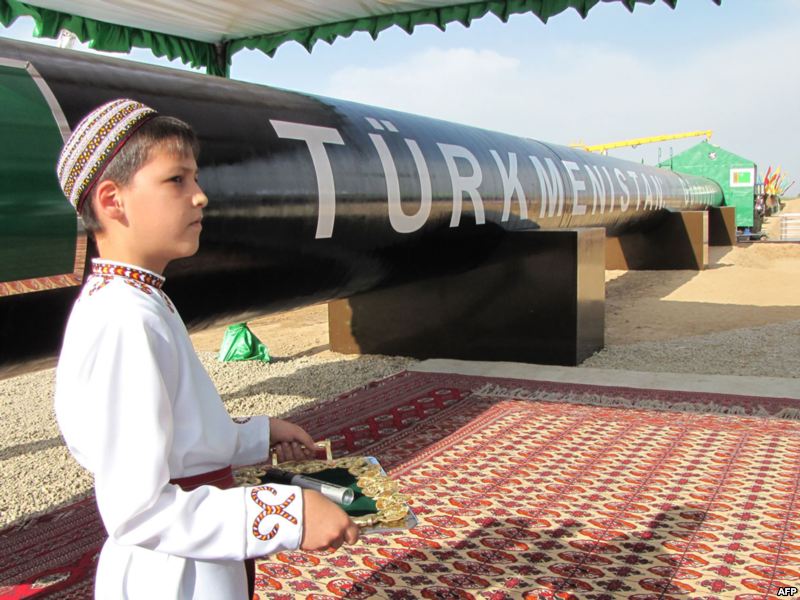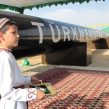
Timely Development Essential For Bringing Turkmen Gas to Europe
Publication: Eurasia Daily Monitor Volume: 8 Issue: 218
By:

Following the second phase of auditing Turkmen gas reserves, the British consultancy company Gaffney Cline & Associates (GCA, one of the world leaders in the profession) estimates the reserves in eastern Turkmenistan at just under 20 trillion cubic meters (the figure deemed most likely, within a range of higher and lower estimates). Those estimates do not include Turkmenistan’s other onshore fields (now past their peak), nor its offshore deposits.
According to GCA, Turkmenistan holds more than sufficient gas to meet any potential demand over the foreseeable future: whether from China, Iran, Russia, Europe, Afghanistan-Pakistan-India, or a combination of those export destinations. This need not be a zero-sum contest. Turkmenistan expects to reach a production level of 230 bcm of gas per year by 2030. However, setting the export priorities in a proper order is essential, as the commercial gas volumes will come on stream incrementally over time (see EDM, October 20, 21).
Onshore reserves are concentrated at the fields of South Yolotan (richest by far), Osman, Yashlar and Minara, almost clustered together in the east of the country. On November 18, President Gurbanguly Berdimuhamedov issued a decree establishing the “Galkynysh” [Revival] gas zone, combining those four eastern fields into a single system for exploration and development (TDH [Turkmenistan State News Service], November 19).
China, Iran and Russia are the largest importers of Turkmen gas, in that order, at this time. Following its shocking experience over the years with Gazprom, Ashgabat has concluded that Russia does not offer security of demand (at least as long as Turkmenistan lacked alternative export options). Accordingly, Turkmenistan prioritizes China. With the opening of the pipeline to China since 2009, Turkmenistan committed to deliver up to 40 billion cubic meters (bcm) annually over a 25-year period to China. It already delivers at an annual rate of 17 bcm at present. Visiting that country on November 22-25, Berdimuhamedov agreed with Chinese President Hu Jintao to increase the long-term commitment to 65 bcm per year, as additional pipeline capacities are commissioned (TDH, Xinhua, November 25).
Russia, which enjoyed a near-monopsony on Turkmen gas at some 45 bcm per year until 2008, is currently importing Turkmen gas at an annual rate of 10 bcm to 11 bcm, reportedly less than Iran’s imports from Turkmenistan. The government in Ashgabat currently prioritizes the opening of the fourth export direction, westward across the Caspian Sea via Azerbaijan and the Southern Corridor to Europe.
Ashgabat added clarity to this intention during its latest oil and gas conference. Turkmengaz CEO, Amanali Khanalyev, reaffirmed the commitment to build an 800 kilometer pipeline from Turkmenistan’s eastern gas fields to the Caspian shore (the East-West pipeline). Berdimuhamedov ordered construction to begin in 2010. This line would supply 30 bcm per year from onshore production for onward delivery by trans-Caspian pipeline to Europe, adding another 10 bcm from Turkmen offshore production. Turkmengaz and the Turkmen pipeline construction company are building some portions of this overland line. Ashgabat initially planned to build and finance it from its own resources. However, it now seeks international inputs for some sections of this pipeline (TDH, Reuters, November 17).
Upstream, however, Turkmenistan has yet to approve production sharing agreements (PSAs) with Western companies for onshore gas projects. Only China’s National Petroleum Corporation (CNPC) holds a PSA for onshore gas development in Turkmenistan at present.
Without PSAs, Ashgabat will find it difficult to attract Western companies in its onshore development projects. Persistent uncertainty on this score will at the very least delay Turkmen production and, thus, the arrival of Turkmen gas in Europe. Other producers, including those of liquefied gas and potentially shale gas, are also targeting the markets of Europe. Those producers, as well as pipeline-gas suppliers such as Russia, seem likely to compete against each other for European markets. In that light, Turkmenistan’s impressive gas reserves will not make a strategic impact in Europe, if the competitors reach those markets ahead of Turkmenistan.
Moscow is waging a rearguard propaganda battle to discourage Western involvement in Turkmen gas projects. Russian officials, such as Gazprom vice-president Aleksandr Medvedev most recently, cast doubt on the magnitude of Turkmen gas reserves, and warn against the geological complexities of those deposits (Interfax-Kazakhstan Oil & Gas Weekly Report, November 28). These arguments, however, proceed from 30 year-old Soviet exploration data; and may equally reflect Gazprom’s current limitations in extraction technologies, compared with Western companies. The government in Ashgabat has dismissed those arguments as “unprofessional,” designed to “attack Turkmenistan’s independent policy on energy. Guided by its national interests, Turkmenistan will continue [pursuing] diversification of its energy export directions to international markets” (www.turkmenistan.gov.tm, November 19).
That is one aspect of Moscow’s opposition to Turkmen gas reaching Europe. The other aspect is its resistance to the trans-Caspian pipeline project, and the most recent ingredient to that resistance is an implied threat of force (see EDM November 30).
The European Commission prioritizes a trans-Caspian pipeline (or pipeline system) from Turkmenistan via Azerbaijan to Europe. The US Company Chevron is said to also consider this option. As a prerequisite to it, European and US companies alike need access to onshore projects and risk-mitigating PSAs with the Turkmen government. Such involvement by major Western companies would also increase political support for a trans-Caspian pipeline, help overcome Moscow’s objections to it, and enhance Western interest in Turkmenistan’s independence and security.




